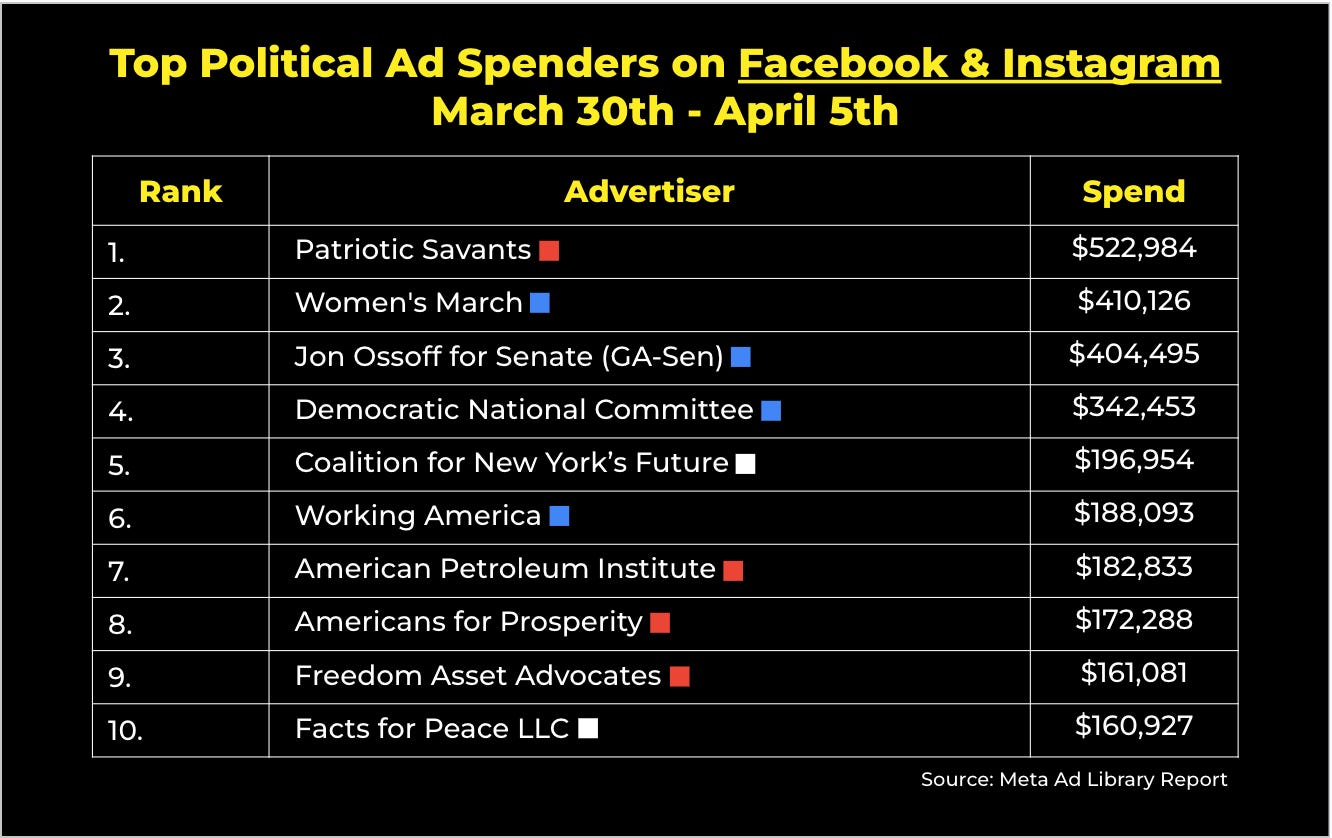The streaming revolution is *officially* taking over
Also inside: Meta allegedly targeted ads at teens showing signs of depression, the Congressional Black Caucus PAC takes on Trump online, and more
This newsletter is sponsored by The NewDEAL and An Honorable Profession.
This week, Valentina Perez and Erica Monteith from GMMB are taking over the Deep Dive section to talk about how streaming is about to surpass cable and broadcast television as how Americans watch TV *for the first time ever* – which, of course, changes the game on how people will consume political ad content. But first…
One more quick note: We’re still looking for guest authors for FWIW! Specifically, we need mission-aligned folks working in this wild intersection of tech, politics, government, and media to share their wisdom (new research, trends, etc.) with us. Please fill out this pitch form if you’re interested.
Digital ad spending, by the numbers:
FWIW, U.S. political advertisers spent about $12.1 million on Facebook and Instagram ads last week. Here were the top ten spenders nationwide:
Both the top spender on political digital ads on Facebook + Instagram, Patriotic Savants, which clocked in at a whopping $522,000+ spent this past week, and Freedom Asset Advocates are running ads featuring lawyer Jim Rickards, who claims to be a former CIA advisor (and seems to be a fairly controversial figure). Rickards also now claims that Trump is about to release a $150 trillion secret congressional trust fund that DOGE allegedly found for the American people – which, according to these ads, will save Social Security and secure Trump a third term.
The ads link to these incredibly sketchy videos – and despite the fact that over $600,000+ were spent in total on these ads in the past week, there appears no corroborating evidence that I could find that the claims these ads make are based on verifiable fact (and it’s also unclear whether or not they violate Meta’s ad misinformation policy – many were still running at the time of publication).
Meanwhile, political advertisers spent just over $3.7 million on Google and YouTube ads last week. These were the top ten spenders nationwide:
The conservative group One Nation started running ads going after incumbent Sen. Ossoff, who is defending his seat in Georgia in 2026. The ads attack Ossoff on costs for seniors and trans athletes (and for those counting, yes, we are still ~570 days from that election).
The Congressional Black Caucus PAC spent ~$2,000 on YouTube ads this past week calling out Trump for cutting federal jobs, 20% of which are held by Black Americans (AKA slashing Black jobs). The ads are running primarily in DC.
On X (formerly Twitter), political advertisers in the U.S. have spent around $2.3 million on ads in 2025. According to X’s political ad disclosure, here are the top spenders year to date:
…and lastly, on Snapchat, political advertisers in the U.S. have spent around $546,800 on ads in 2025. Here are the top spenders year to date:
What’s trending on YouTube:
Every week, we’re tracking the top-viewed channels on YouTube in the US in partnership with our friends over at Tubefilter:
A YouTube channel that got a lot of attention this past week was BeamngShorts, which came in at #6 this week. The channel itself, while not overtly partisan, has some fairly intense stuff randomly sprinkled into its videos. And taking a look at some of its most popular content (NOTE: this chart tracks which channels are getting views and attention, regardless of when the content itself was actually posted), they appear to have a “Girls vs. Boys” Shorts series that is racking up millions and millions of views… which features Trump, Obama, and Biden making dirty comments (content warning on this!) and also an allusion to 9/11.
🎧 Advancing the Next Generation of Democratic Leaders on An Honorable Profession
NewDEAL CEO Debbie Cox Bultan and IA Sen. Zach Wahls, Executive Director of The Next 50, detail their new collaboration to build a robust pipeline of Democratic talent who will win tough races and deliver results for years to come. Tune in to An Honorable Profession to hear more and check out past episodes with Jennifer Pahlka, Symone Sanders, and Pete Buttigieg.
The streaming revolution is *officially* taking over
👋 Hey, we’re Valentina Perez and Erica Monteith from GMMB, filling in for Lucy this week. We’re digital communications strategists who work with campaigns, causes, and coalitions to win tough fights and move people to action. From the presidential to the hyper-local, we help organizations meet voters where they are–and right now, more than ever, that means on streaming.
Streaming hasn’t just changed what we watch on TV; it’s transformed how we watch video. What started with red Netflix envelopes has evolved into an always-on, highly personalized viewing experience across TVs, phones, and tablets. And we’ve seen firsthand how it moves voters.
The “streaming evolution” has been a long time coming given the steady decline in traditional television consumption and the rise of cord-cutting. And for the first time ever in our history, streaming is about to surpass cable and broadcast television in how Americans watch TV, according to Nielsen.
Even with changing habits, Americans still watch a staggering amount of video—about 6 hours and 45 minutes a day, including over 4 hours on TV screens alone. (And that’s before we account for nightly doom-scrolling on smartphones.)
People haven’t stopped watching TV, they’ve just stopped watching it traditionally. Now, they’re on Hulu, Peacock, Tubi, and YouTube, flipping between The White Lotus (Piper, nooOO) and PBS NewsHour without ever touching a cable box. This shift doesn’t just have cultural implications–it also has strategic ones.
Bottom line: If you’re still planning your media like it’s 2016, you’re already behind. Campaigns aiming to win hearts, minds, and elections must embrace advertising on streaming platforms to succeed.
Streaming delivers the reach of traditional TV and the precision of digital platforms. It allows us to get in front of voters where they spend time daily and helps maximize every media dollar.
At GMMB, our work with Everytown for Gun Safety leans into streaming to reach voters around the shows, movies, and sports they already follow. In 2024, this approach helped mobilize Democrats in key zip codes and contributed to wins in toss-up races like CA-45, CA-27, NY-04, NY-22, and others.
Streaming was also critical in passing New York’s Equal Rights Amendment last fall, enabling us to efficiently reach key audiences—like Black, Latina, and non-college-educated women—in the expensive New York City media market.
We’ve also seen huge success in layering tools like Automated Content Recognition (ACR) data onto streaming programs to ensure that people who see opponents’ ads also see our messaging. In 2022, leveraging ACR data in Gretchen Whitmer’s reelection campaign helped us reach hundreds of thousands of Michigan voters to debunk Republican attacks on the governor.
However, winning in this new media ecosystem means that streaming can’t stand alone. Even on ad-supported platforms, we can’t reach everyone due to political content regulations. Additionally, 60% of U.S. streaming subscriptions remain ad-free, as of 2024. FWIW readers already know that layering additional digital tactics like online video, social media ads, creator programs, paid search, podcasts, and more are necessary to reach voters holistically and authentically.
We have many hard fights ahead of us, but we’re not showing up empty-handed. Maximizing tools like streaming and ACR data to reach voters in today’s fragmented landscape is how we win in 2025 and beyond.
More from around the internet:
Axios is out with new research that shows that young people who voted differently are also starkly divided when it comes to their consumption of social media, TV, and (you guessed it) podcasts. And FWIW, re: young people and the cultural impacts of social media, I recently watched Adolescence and Bad Influence (ft. Taylor Lorenz!) – both are excellent and completely horrifying.
Speaking of teens, Meta whistleblower Sarah Wynn-Williams testified in the Senate that Meta targeted teens with ads based on their emotional state, including when they showed signs of depression…
These are the Big Tech billionaires who donated, in most cases, millions to Trump. Now, even with Trump’s pause on tariffs, they’re out billions of dollars.
And speaking of billions, billions of people are now watching the WNBA on YouTube – and WNBA content is experiencing HUGE growth on the platform.
It appears the box office might have been saved by a viral TikTok trend that involves teenage boys going insane during the “Chicken Jockey” scene in the new Minecraft movie.
Our weekly clips round-up is back! Every Tuesday, paid subscribers will get a debrief on the stories about politics, tech, social media, media, and journalism you need to be tracking. If you haven’t signed up yet, you can right here ⬇️
That’s it for FWIW this week. This email was sent to 24,249 readers. If you enjoy reading this newsletter each week, would you mind sharing it on X/Twitter, Threads, or Bluesky? Have a tip, idea, or feedback? Reply directly to this email.













